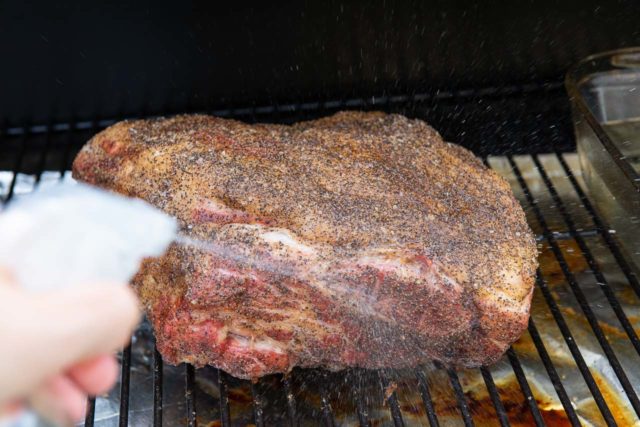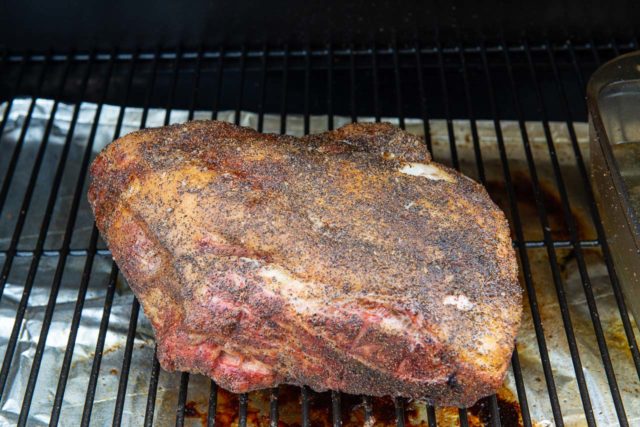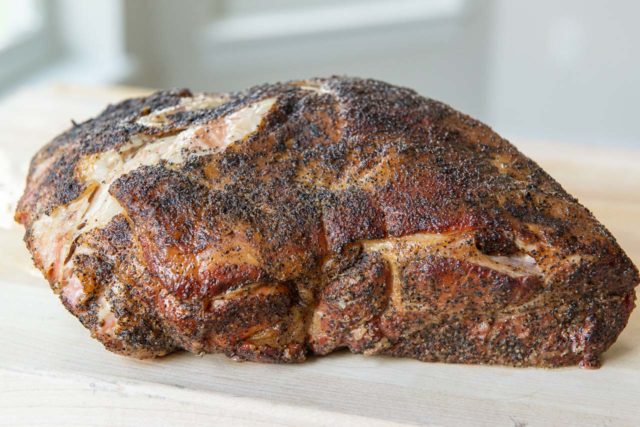Smoked Pork Butt
This Smoked Pork Butt shreds like a dream into the most flavorful and juicy pulled pork. It incorporates methods from legendary BBQ master Aaron Franklin, and is truly delicious enough to eat on its own, or in sandwiches. It’s also one of the simplest meats you can make on the smoker.

Smoked meat is the best meat, and oh my heavens this smoked pork butt recipe is SOOOOO good. Serve it with a side of Coleslaw, Creamed Corn or Cornbread and you truly have an epic BBQ feast.
This is a recipe that I’ve wanted to share with you for ages, and one that I started working on after watching Aaron Franklin’s Masterclass last summer. Yes, I’m talking Aaron Franklin of the legendary Franklin BBQ restaurant in Austin, Texas. I’ve tasted the greatness of his BBQ and I’m grateful to him for sharing all his secrets.
Smoking is always a low and slow cooking endeavor, but the reward today for you is the most incredible shreddable and juicy meat with a hint of smokiness.
Why This Recipe Is The Best
The meat is the star – While I can appreciate that there’s a time and place for fancy meat rubs and BBQ sauce, a lot of times people use those to cover up an inferior smoked meat. This recipe is all about a dang good piece of pork that is smoked perfectly. No sauce is used (though you can add it at the table, if you like), and the seasoning is simply salt, black pepper, and paprika. Using only a few simple ingredients allows you to appreciate the flavor of the meat. That for me makes for the best pulled pork.
Great smoke flavor – The pork butt spends hours in the smoker unwrapped to get a hearty dose of smoke penetrating the outside.
Juicy, tender meat – There are several tricks here that will ensure you don’t end up with dry pork. The meat is so juicy and shreds beautifully.
Minimal fuss – I smoke various cuts of meat all the time, like ribs and brisket, and this is arguably the easiest cut to make. It’s great for beginners!

Tips for Best Results
Use the right wood – Certain types of wood are more compatible here than others. My top recommendations for pork are Cherry, Pecan, and Apple wood.
Use a bone-in pork butt – You really want a bone-in pork butt here. Boneless butts will have a more uneven shape, which may result in less uniform cooking. Cooking meat on the bone also improves the flavor, moisture, and handling during cooking. The bone will slide out easily at the end, so don’t worry about it.
Wrap and spritz – Some people say they prefer not to wrap the meat at all because they like a crispy exterior. In my experience, it’s not the kind of crispy I like, as it can become very dry. Wrapping the meat will also help you get through the stall in temperature (more below) and keep the fat and juices inside the foil.
Step by Step Overview:
This is a simple, sauceless preparation of pork, though you could certainly serve it with some BBQ Sauce if you prefer. The pork butt is rubbed with mustard, covered with a salt, pepper, and paprika mix, then cooked low and slow for hours until tender.
While Aaron uses a different kind of smoker than I do, I was able to adapt most of the principles and cook this in my Traeger, which is a pellet smoker.
So long as you follow the temperatures given, I’m sure you could make this in any smoker setup that you have. I’ve even read about people turning their charcoal grill into a smoker.
How much meat do you need?
To get the number of people the pork butt will serve, I assume 1 person is served per every pound of raw meat.
So here I’ll be cooking an 8lb pork butt, which should serve about 8 people. This is on the generous side, but I find that people love this so much that they might eat more than a “normal serving” of meat.
Coat the Meat
To get started, rub yellow mustard all over an 8lb bone-in pork shoulder butt roast (note, sometimes this is called Boston butt at the grocery store):

The mustard probably sounds weird, but this is one of the fantastic tips Aaron gives in his class. You don’t really taste it at the end, and it helps the seasoning stick to the meat.
Sprinkle On the Seasoning
Next, mix together salt, pepper, and paprika in a shaker for your dry rub, and shake it all over the outside:

Aaron emphasizes that you really want to coat it generously, because the meat in the center isn’t going to have any seasoning. So you almost have to overseason the outside.

If you want something with a bit more flavor, this Pork Rub is a great choice.
Get the Meat On The Smoker
Place the pork butt on a smoker set to 275 degrees F, fat side up, and make sure to add a pan full of water to the grate.

This was one of Aaron’s tips from the class and WOW does it make a difference. I’ve smoked a lot of meats now, and there was one time when I forgot to put the water in and the end result was a lot drier.
Smoke the pork for 3 hours, undisturbed, at which point it should look like this:

Spritz
Spritz the meat with a spray bottle filled with water or apple cider vinegar, and keep cooking for 3 more hours, spritzing at every 1 hour interval:

Why Do You Spritz The Meat?
Before I started smoking meats regularly, I had heard the idea of spritzing meat with water or apple juice, but didn’t understand what it was for. Spritzing cools the outside of the meat down so that it doesn’t overcook and dry out. It’s another technique that makes a huge difference in the end.
After the second three hour period, check the temperature of the pork using a thermometer (affiliate). It should ideally be around 165 and you may notice the fat cap on top has split.

The Stall
Usually around an internal temperature of 165F, you will hit a stage of cooking called The Stall. Aaron explains that this is caused by evaporative cooling, when the meat starts to tighten up and force moisture to the surface, cooling it down.
If you don’t increase the temperature or wrap the meat, it can get “stuck” at this low temperature for a while, and we need to hit a target temperature of 200F. Here we will increase the temperature 25 degrees, and also wrap the pork in foil.
Time to Wrap
It’s time to pull the pork butt off and wrap it in foil. While Aaron uses a more breathable butcher paper for brisket, he recommends aluminum foil for this recipe.

Aaron recommends spritzing the foil thoroughly and spritzing the meat one more time before wrapping it up.
Make sure to use a generous amount of foil and really wrap it tightly:

Cook Even More
Keep cooking the pork for another hour, increasing the temperature slightly, at which point it should get to the final target temperature of above 200F.
If you pick it up with mitts, everything should feel like pretty tender, but I like to check with a meat thermometer inserted into the center of the cut of meat. I usually prefer to take it closer to 204F to really ensure the connective tissue has softened.

Let the Meat Rest
Unfortunately, it’s not time to eat yet.
It’s important to let the meat rest, for about one hour, in the foil. If you keep it well wrapped, the internal temperature of the meat will stay high enough that it’ll be warm and enjoyable an hour later.
This is a good time to get your sides together, whether it’s Coleslaw or my Cornbread Recipe or some Crispy Smashed Potatoes.

Once the smoked pork butt has rested, shred it up with a fork, tossing it with any of the rendered fat that was captured in the foil.

How to Serve It
The flavor here is so glorious that I do not add sauce or anything else to the smoked pork. To me, doing so would mask the flavor you worked so hard for. I will usually just serve the meat shredded on the plate, with some complimentary sides like Homemade Cornbread, Coleslaw, or Corn Avocado Black Bean Salad.
You can also put it into sandwiches like Pulled Pork Sandwiches, make Pulled Pork Bruschetta with Caramelized Onions and Mozzarella with it, or press it into a panini.
Slow Cooker Pulled Pork is another great recipe if it’s too cold to get the smoker out. I also love my Oven BBQ Pork Spare Ribs and Parmesan Crusted Pork Chops. Enjoy!
Recipe FAQ
These names are used somewhat interchangeably, probably because they both come from the shoulder. However, pork butt is cut from higher up. The Smoked Pork Butt is not actually the rear of the pig.
This is at its absolute peak when eaten fresh, but I almost always have leftovers because it’s a big piece of meat. I recommend shredding the meat while it’s warm because it’s much easier than trying to shred cold meat later. Store in an airtight container for up to 5 days.
The meat will freeze beautifully in an airtight container for up to 2 months. Before reheating, thaw by moving it to the refrigerator the night before.
I like to fry it up in a skillet on the stove so it’s moist but also crispy. I recommend adding a tablespoon or two of lard first, so the meat doesn’t dry out. The heat time will depend on how much you’re cooking and the size of your skillet. If heating a 6-ounce portion, cook over medium high heat with 1 tbsp of lard for about 3 minutes, until warmed through and browned.
Aaron recommends bone-in and I agree. I tend to almost always prefer bone-in meat, and boneless pork butt can have an uneven shape that will affect cooking.
Spritzing cools the outside of the meat down so that it doesn’t overcook and dry out.
Recipe Variations
While this is not a sweet way to prepare the pulled pork, there are a few different ways you could add sweetness here if that’s what you prefer.
You can use a pork rub that has a little bit of brown sugar in it. You can pair it with a barbecue sauce when serving. You may also spritz with apple juice during smoking.
Did you enjoy the recipe? Please leave a 5-star rating in the recipe card below and/or a review in the comments section further down the page. Or, follow me on Facebook, Instagram or Pinterest!

Smoked Pork Butt
Ingredients
- 8 lb bone-in pork shoulder butt roast
- 2 tbsp yellow mustard (approximately)
- 1/3 cup salt, pepper, paprika mix*
- water or apple cider vinegar** in a spray bottle
Instructions
- Rub the pork all over with the mustard, spreading it as evenly as you can. The amount doesn't matter so much as making sure that the entire outside is coated in a thin layer.
- Season the pork all over with the salt, pepper, and paprika mix. Try to use an even back and forth motion to make the coating as even as possible. Now let the meat sit at room temperature for 30 minutes while you heat up the smoker.
- Prepare the smoker and preheat to 275F. Place a container full of water in the smoker, then add the pork butt so that the fat cap is facing up. Cook for 3 hours, undisturbed.
- Spritz the pork all over, then continue cooking for 3 more hours, spritzing at one hour intervals. As you spritz, try to sweep across using your wrist to disperse the spray, instead of hitting any one spot too hard.
- Check the meat with a thermometer, and ideally it should be around 165F. If it's not at least 160F, check to see if the fat cap on top is split. If it is, proceed to the wrap. If it's not, keep cooking in 15 minute intervals, until the temperature reaches 160F.
- Get a really large piece of aluminum foil that's four times as long as the pork, spritz the inside, then place the pork on the spritzed area, and spritz the pork as well. Wrap the pork up tightly with the foil. There should be a generous amount of foil encasing it, so the juices don't spill out.
- Put the meat back on the smoker, and increase the temperature to 300F. Cook for one final hour.
- Using oven mitts, pick up the pork and check for tenderness by shifting it around in your hands. If it feels tender, insert a thermometer through the foil and check that it's over 200F.
- Let the smoked pork butt rest in the foil wrap for one hour.
- Carefully unwrap the foil over some sort of surface that can catch the juices, then shred the pork with a couple forks, making sure to toss it in any juices from the foil. Serve immediately as is, or stuff it into some Homemade Whole Wheat Hamburger Buns. Enjoy!
Notes
Nutrition
Nutrition is estimated using a food database and is only intended to be used as a guideline for informational purposes.

15 Comments on “Smoked Pork Butt”
I love smoking bone in pork butt
Its one of my favorites too!
Great 👍
What would be the type of wood used for smoking the Pork Butt?
This is up to you. Traeger has a chart for recommended pellets with pork, and they are Alder, Apple, Cherry, Hickory, Maple, and Pecan.
Most excellent. Great presentation. Great flavor
I pretty much always smoke that same way but inject with Cherry Dr Pepper.
So good
Looking forward to trying this tomorrow.
Thank you very much for posting this recipe. It turned out great!! Was wondering if you can omit the water pan if the smoker has a drip tray that holds water? We did the extra pan with water but it seems like it might be overkill.
Process looks great. Should be a subtle but nice upgrade from my current method.
I was curious I didn’t see what type of wood is used for smoking. Some say it doesn’t matter, others are quite particular! Your thoughts?
Thanks,
NFBASCOMB
nfbascomb@gmail.com
I’m not sure if you have a Traeger specifically, but you are supposed to use their pellets so that’s what I do. I follow their recommendations for which pellets to use for which types of meat. I honestly haven’t settled on which one is my favorite or go-to for each one though. I think I would fall in the “it doesn’t matter” camp, with the nuance that you should choose one of the ones that is regarded as compatible for that type of animal. Does that help?
Thank you for this, it was great to see all the details given, thanks!
Awesome, happy cooking!
Can you inject it with flavor? You mentioned that most of the flavor will be outside not inside.
I’ve actually never tried doing this, though I am familiar with this concept. If this is something you do regularly, I’d say go ahead. Definitely one of the themes in Aaron’s class was keeping things simple so you can taste the meat, and I prefer my smoked meats along these lines as well. I found the pork to be very flavorful but this is a personal preference to some degree.